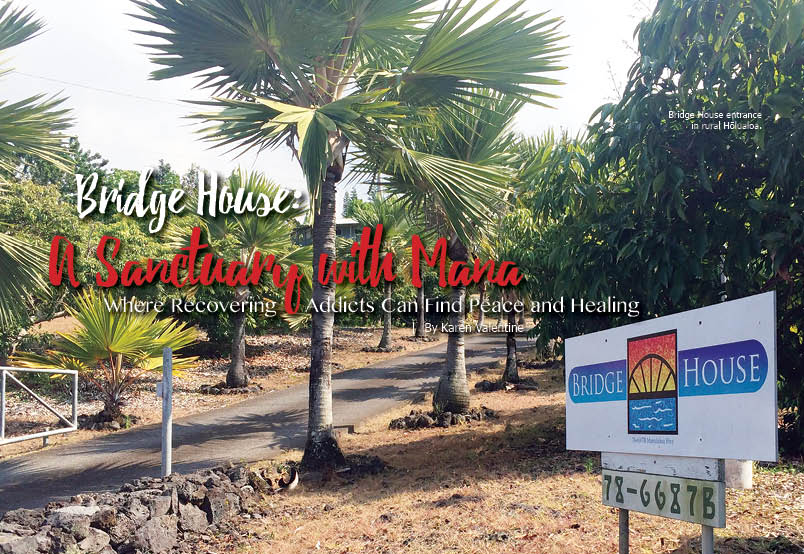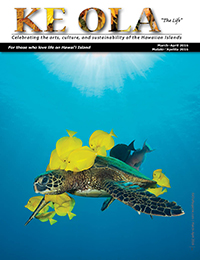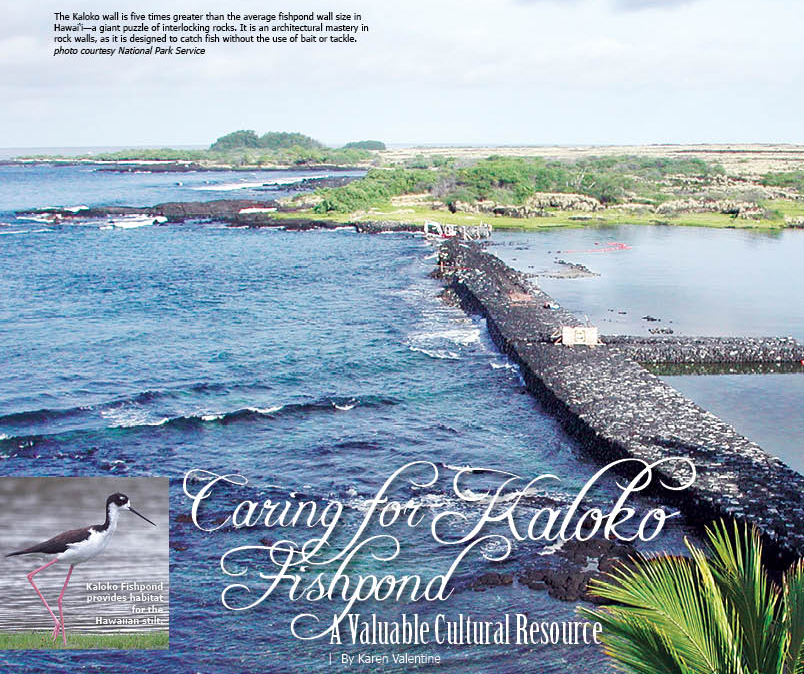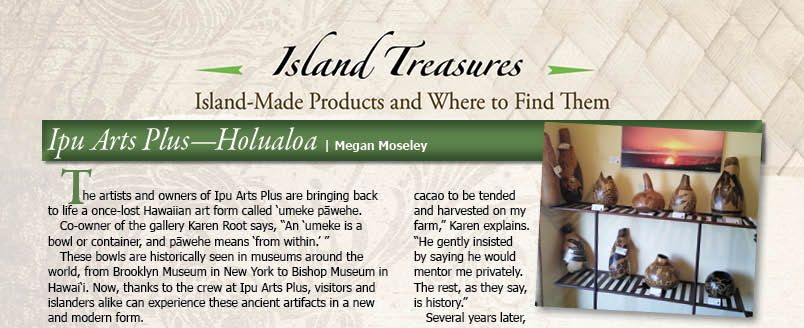
Bridge House: A Sanctuary with Mana, Where Recovering Addicts Can Find Peace and Healing
It’s a rocky road full of pitfalls and the illusion of adventure, the life of a drug and/or alcohol addict. For those who want it to end, at the end of the road is a place called Bridge House.
Executive Director Mark Schuster believes the West Hawai‘i residential clean-and-sober facility is unique in both Hawai‘i and the mainland. He doesn’t mince words when speaking of the policies and rules of the government agencies that fund and regulate programs that he feels fall short of recognizing the deeper issues of personal growth and recovery. Since joining Bridge House in 2004, after working in treatment programs in California and O‘ahu, he’s come to the realization that grass roots and Hawaiian values can work better than classrooms.
After being in private practice as a psychologist in San Diego, doing work with forensics and the courts, Mark took a job on O‘ahu at Kapi‘olani Medical Center for Women and Children in a program for highly disturbed children and adolescents. While there, he learned about the need for a new director at Bridge House in Kona.
“I left a really good job that I enjoyed, with good pay and benefits. This is a lot different, but I wouldn’t trade it for the city. Six months after being here, I got in tune with the spirit here, with the mana and people. This is where I want to be.”
Mark’s formal education is in both psychology and anthropology.
“When I started working with heroin addicts in San Diego, I fell back on my anthropology. I told myself I’m just going into another culture I know nothing about; they have their own mores, their own language. You realize there’s a whole undercurrent; they’re not just regular people doing drugs. I sometimes think my anthropology training is a lot more valuable.”
As a kid growing up in rural Connecticut, Mark was around the elders who he says passed on wisdom you can’t get in schools.
“Sitting in a duck blind with old Yankee farmers,” he says, “there’s a lot of wisdom. They weren’t educated, but they knew how to handle people with problems.”
That understanding led Mark to develop a down-to-earth program at Bridge House, utilizing the seven-acre property, local kūpuna and Hawaiian practitioners, in addition to following the required protocol mandated by the state and federal agencies.

Residents at Bridge House come with addiction, whether to drugs or alcohol. According to Mark, some 80 percent have ice (crystal methamphetamine) as part of what they’re doing, maybe 15 percent are alcoholics and five percent have pharmaceutical addictions. Ice is a problem that hasn’t decreased over the years, but research is improving, Mark says.
“Ice has always been the fly in the ointment here. I would rather be locked in a room with 100 heroin addicts than three ice heads. So much new information is now being pumped out by the National Institute on Drug Abuse. The main thing they’re discovering—using brain imaging—is which parts of the brain are affected. The good news is that it’s not damaged, it’s just deactivated.”
He thinks the Bridge House program is effective in healing those disconnections.
“When I got here, I saw seven acres of farm land. I’m a farm boy. I said, ‘why aren’t we using this?’ And we have elders too, like the elders I knew who could talk about the important stuff. Let’s reconfigure the program because it’s not hard to get people clean, but when they go into the drug subculture, what’s changed is their character. It does nobody any good if they leave here and they still have their attitude. Most programs don’t change character. We are different; we’re a lot more interested in their character.
“The State of Hawai‘i requires concurrent enrollment in an outpatient program, which is very much a classroom endeavor, with the teacher and pupil, the lecture and the test. It takes focus and concentration, an ability to recall, and abstract thinking you can use later. Those three functions require the use of the three centers of the brain most impaired in ice use. We have to immediately send them out three hours a day, three days a week to classrooms. I think it’s ludicrous. They don’t get anything out of it and need some time for brain healing/detoxing first.”
Bridge House also runs an outpatient program, and Mark thinks it’s an important component of the program at the right time.
The program at Bridge House incorporates multiple strategies. “There are a lot of people here who are willing to help. We have people doing ho‘oponopono and growing Hawaiian plants for health and healing. We’ve got a naturopathic physician and acupuncturist. We’ve got a kumu hula and kūpuna who come in and talk about Hawaiian values.”
One of two community-based assets for Bridge House is Dr. Joseph Kassel—“Dr. Joe”—a local naturopathic physician and acupuncturist specializing in detox. He spends two days a week at Bridge House, working with healing plants in the garden, conducting ho‘oponopono sessions, and doing acupuncture. The other is Kumu Hula Bobo Palacat—“Uncle Bobo.” A lifelong resident of Kailua-Kona now living in the Hōlualoa area, Bobo spends one day a week talking story, sharing Hawaiian values, and teaching Hawaiian practices such as lauhala weaving, ipu growing and finishing, and hula for those who are interested.
Recovering alcoholic, mother and local girl, Jamie B, is one example of a former resident who has found a new life.
“I saw that everything was buried inside her because she went to that dark side,” Mark said. “After going through the program here, she just blossomed. She’s one of our real success stories. She now works here with our gardens and cultural program.”
Jamie shares her story:
“I was born and raised on O‘ahu, and I’ve lived here now for many years. I’m a graduate of Kamehameha Schools, a recovering alcoholic, and also a single mom. It was a series of run-ins with the law that eventually brought me to a place that I could admit to myself that I needed help. I experienced a lot of anger and feeling different. My parents died when I was young and, being called an orphan, I identified with a real negative self-identity. Raising my kids by myself, I was very isolated, like most alcoholics. I thought nobody understood. My oldest boy was in 9th grade and two younger ones in elementary school. At the end, I became extremely self-destructive. With my charges, I knew CPS [Child Protective Services] was going to get involved. It was the last straw for me. I started attending 12-step meetings, and someone there said you should try this place, so I called, and a couple weeks later, I came here. It’s just about the best thing I ever did.”
Bridge House, with limited housing space for only 15 residents at a time, has a waiting list, says Mark, yet people are coming and going on a regular basis. Currently there are five beds for women and 10 for men, and they can stay for up to six months each fiscal year.
“We require they have 30 days clean before coming here as a commitment to recovery. When someone first comes in, they’re spinning; their brains are still detoxing. We offer sanctuary, but we keep people on a tight leash. We watch them as they start on a continuum of care.”
Jamie came to Bridge House in early 2010. She continues her story:
“I was just numb when I first got here. I was at that place of ‘help me; just tell me what to do.’ I was open, and I’m grateful I reached that point before I came here. Just having to follow basic house rules, I didn’t have to think. It was really a relief for me. I got started in the program, which includes vocational rehab that, for me, was working in the garden. I grew up in Honolulu where we never had dirt to play in. I remember the very first time I went into the garden. I stuck my hands in the dirt and it was like electricity. I felt this connection I never felt before. It was at that point I started my cultural journey and became curious what it was to be Hawaiian. The aunty who was in charge of that program at the time, she meant the world to me. She would sit us down, and the first thing she would ask us is, ‘Who are you?’ For so many of us in recovery, we don’t know who we are. So I was able to connect with my genealogy, where did I come from? What is my kuleana (responsibility)? What is my place in this world? It’s just come full circle to a place where I would like to help others to feel that connection, to appreciate the culture and just the land here to give us a real sense of healing. After I was a year sober, I got [my children] back and they’ve been with me ever since.”
Another key part of the Bridge House program is vocational skills building, and it is mandatory that all residents participate. They are assisted with job skills, and there are many graduated residents out in the community to help in getting them hired, says Mark. The job/work success rate for Bridge House residents after leaving the facility is 70 percent—meaning 70 percent will still be employed six months after they leave, more than double the national rate of just 30 percent.
“People here, even when the brain is still addled, can improve with these things,” Mark says. “I can take this program to any of the top psychiatric facilities I’ve been with on mainland and it will be successful. You watch what happens when the kūpuna are there in the garden. I see the difference from what I observe in the classroom. Not only are they sitting and focused, they ask questions. These are people who can touch them by talking about basic values we all share.”
Jamie says, “Being a mom, being a member of the community, being a woman, it’s so important to have a safe place. Cultural differences will always arise. For me, it’s more about teaching love and respect. Just be open to receive the mana that is here and what we can share with each other. This is the first place I ever felt safe. This is where I grew up.” ❖
Contact Bridge House: 808.322.3305, email
Contact writer and photographer Karen Valentine



